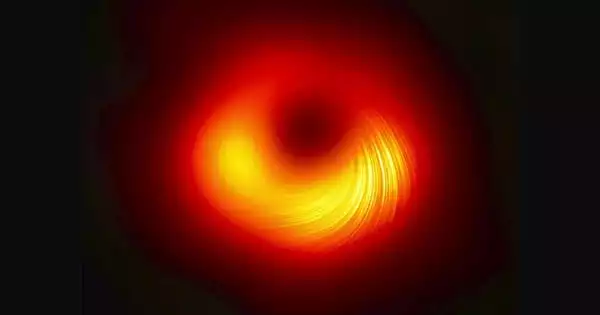The search for a hypothetical subatomic particle that could indicate new physics has narrowed slightly, due to light spinning around a massive black hole in another galaxy. Although light particles cannot escape a black hole, this does not mean they are destroyed. Once a particle of light (‘photon’) travels through a black hole’s ‘event horizon,’ it can no longer escape, but there is no evidence that it is destroyed.
The axion, a lightweight particle, has been offered as a solution to the question of why the universe has so little antimatter, as well as a contender for the elusive dark matter that fills the universe. The twisting and chaotic environs of galaxy M87’s central black hole, the first black hole to have its picture taken, are thought to encode information about such particles.
Researchers write March 17 in Nature Astronomy that the specifics of how light around M87’s black hole are orientated may rule out the possibility of axion particles in a specific mass range. This work also demonstrates that scientists might use a similar strategy in future astrophysical surveys to look for these particles in a variety of masses.
“It’s a pretty fascinating idea,” says the University of California, Berkeley physicist Benjamin Safdi, who was not involved in this study. “They devised a new way and demonstrated that it could, in principle, work.”
This is exactly the information that we need to carry out this theoretical proposal. We have a very extreme condition that can produce a large number of axions, and we have the right tool to study the axion’s signature.
Yue Zhao
Axions, which were first suggested in the late 1970s, have yet to be discovered in testing. Since that initial idea, theoretical work has revealed that an extended family of axions may exist, with each type having a different mass but all interacting weakly with ordinary matter. Yifan Chen of the Chinese Academy of Sciences in Beijing and colleagues developed a method for looking for axions using measurements of the light near black holes in 2020.
A fast-spinning black hole, according to theory, can form a dense clumping of axion particles in its immediate surroundings. The type of axions that form are determined by the width of the black hole. And the supermassive black hole in M87 has the right size for brewing a stew of ultralightweight axionlike particles. If this black hole indeed kicked up such a cloud, that would change the orientation, or polarization, of the light coming from that region. In particular, the polarization would wobble over time.
Until last year, no one had any images of polarized light from a black hole to examine. That’s when the Event Horizon Telescope, or EHT, an Earth-spanning network of radio telescopes, revealed its image of the polarized light surrounding M87’s supermassive black hole.

This is “exactly the information that we need to carry out this theoretical proposal,” says particle physicist Yue Zhao of the University of Utah in Salt Lake City. “We have a very extreme condition that can produce a large number of axions, and we have the right tool to study the axion’s signature.”
So Zhao, Chen, and colleagues looked for a time-varying shift in the polarization’s direction in the EHT data. While an axion cloud would change the orientation, so would the dynamic and chaotic region surrounding the black hole. Zhao describes this as a “sort of inevitable background that we have to cope with.” After subtracting that from the whole signal, scientists discovered that there isn’t enough wobbling to conclude that any signal could have come from the axion cloud. They ruled out the occurrence of ultralightweight axions with masses of around 10 billionths of a billionth of the mass of an electron.
However, the same method might be employed to search for other axionlike particles. “The larger the black hole, the lighter your mass,” Zhao explains. The scientists want to leverage future observations of other black holes by the EHT to seek axions of various masses. According to Zhao, one black hole on EHT’s radar is the behemoth in the heart of our own galaxy, which is around one-thousandth the mass of M87’s. If our galaxy’s giant black hole is surrounded by a cloud of axions, those are heavier particles.
“This idea of seeking for these axionlike particles is, in my opinion, the most interesting thing going on in particle physics right now,” Safdi says.
















